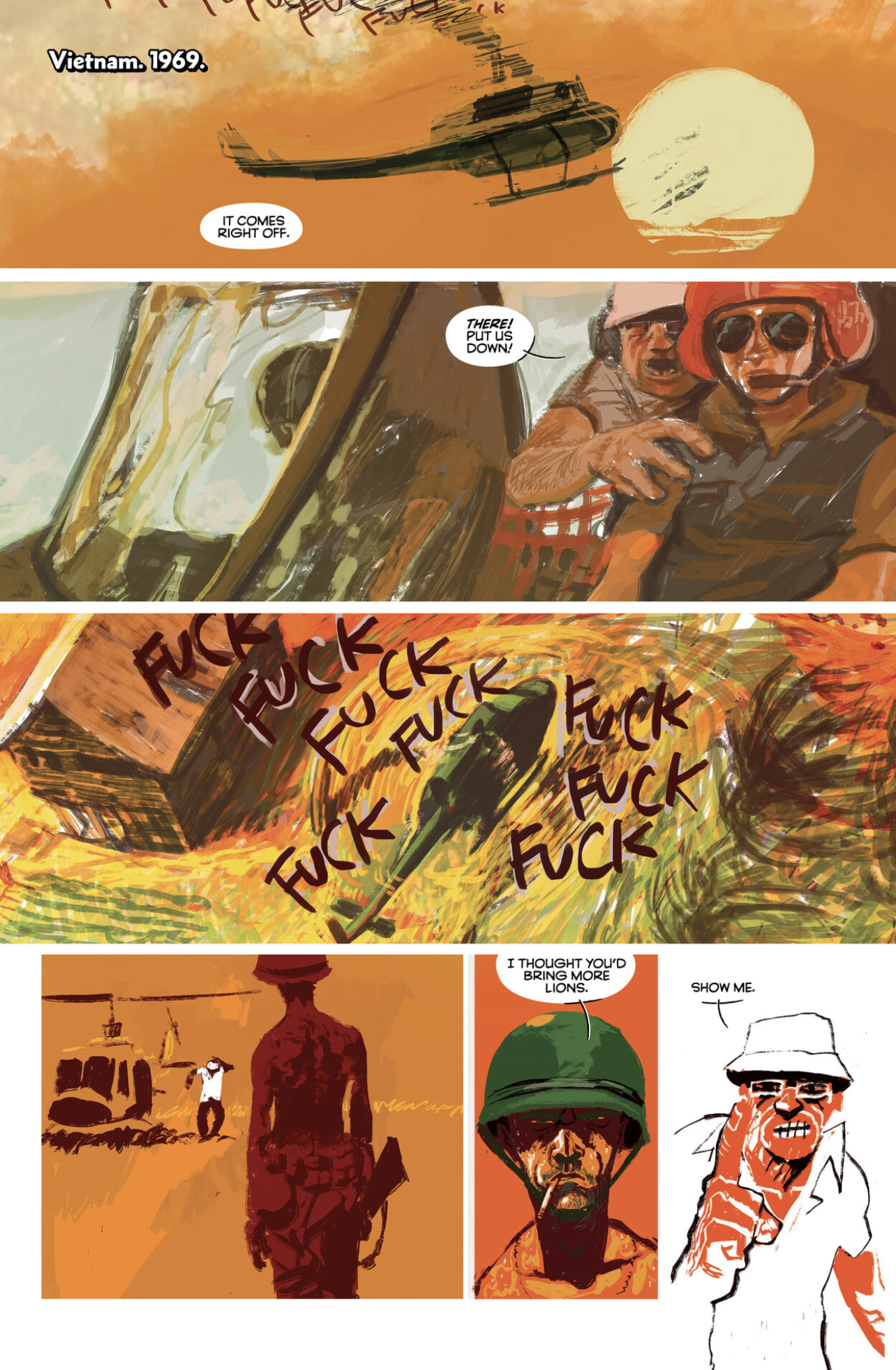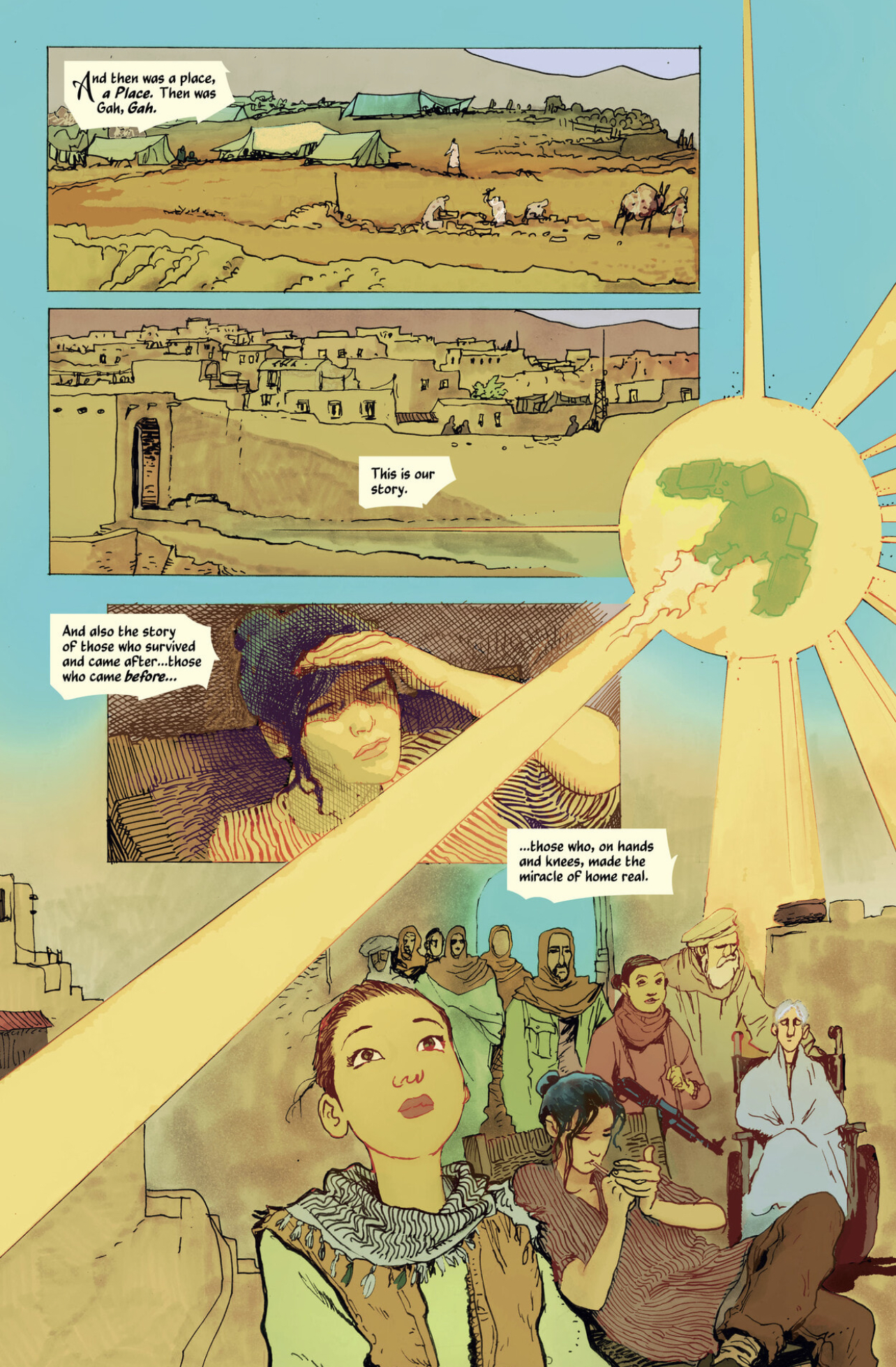Deniz Camp had a very good 2022. This realization came upon me all of a sudden, as I realized he had launched and was writing, more-or-less concurrently, three very good comic book series across last year. In the first place, he gave us new adventures of Valiant’s (literally) deathless black ops hero in the pages of Bloodshot Unleashed; in the second, the splendid, satirical Agent of W.O.R.L.D.E. at Scout Comics; and in the final place, of course, our ostensible subject for today: 20th Century Men.
What do these three books have in common? I mean, besides the writer? Well, I’d say what all three have in common is that they have spectacular art: Bloodshot is drawn by Jon-Davis Hunt, W.O.R.L.D.E. by Filya Bratukhin, and 20th Century Men by Stipan Morian. None of these books work without fantastic art. Admittedly, I bailed on Bloodshot because I just cannot stand the character and the general air of post-Shooter Valiant - I verified that it looked really strong, and that Hunt is definitely someone to watch. When he’s drawing someone other than Bloodshot. Sorry! Likewise, W.O.R.L.D.E. wasn’t the first time I had seen Bratukhin’s work. At the very least he’s put out a number of striking Batman variants that have circulated the internet periodically. He’s going to find himself priced out of interiors very quickly if he doesn’t watch it.
Frankly, what sticks out is that Camp must be doing something right to be the common denominator in projects by these three gentlemen. As I said, an enviable 2022.

And my goodness, have I been dragging my feet about writing this review! I only sat down to read the whole thing—20th Century Men, that is—a couple days back. After having picked it up in serial and flipping through as it went, but generally putting off any deeper engagement owing to how much it looked like a story that needed to be read in one fell swoop. And it is definitely a story that will be read and appreciated as a book with a spine more than as a stack of pamphlets. I anticipate many people will buy the collection in May.
There’s the rub! No suspense here, as far as this critic is concerned. I arrive with old news. The word is out and there’s already a great deal of praise for the book. And in case you’re worried the Journal is about to pop off some kind of trademark iconoclastic demurral, well, worry not, true believer: I’m here to affirm that the book is every bit as good as you’ve heard. Largely due to the protean talent of Stipan Morian, it must be said - this could have been a very dry comic in another set of hands. As it is, this is one of the most visually audacious comics I’ve seen in many years. There’s no stable shape to the narrative, seemingly no default format or grid. There are pages with regular grids and also big double-page spreads; pages with a lot of panels, and pages with no panels whatsoever. Sometimes there are a lot of lines on the page, sometimes barely any lines whatsoever.
Morian is Croatian, a fact that seems relevant since the artist he most reminds me of is fellow Croatian Igor Kordey - who shows up for a variant cover on the very first issue, so it’s hardly a specious connection. Both artists share a fiendish elasticity, and it's that prodigious variety that carries 20th Century Men. I see in places the loose, loping line of later Kyle Baker. Sometimes close-ups are given with the precise hatching of an Ōtomo, sometimes with the splotched reds of an Elizabeth Breitweiser. When the scene is set in Vietnam, Ralph Steadman stops by, and when we meet the Soviet Superman the panels fall into a hazy penciled indeterminacy that resembles Tom Scioli.
It’s a good-looking book, is what I’m trying to say. The visuals are a holistic treat - it’s all Morian, save for the letters by Aditya Bidikar. The mood changes with the scene; every era in the story has its own palette, every character their style. We see beautiful women and old men detailed with the most delicate of smooth lines, and we see homicidal American war machines that lurch like smears.
The story itself - well, the elevator pitch rather minimizes the endeavor. Because from one point of view, yes, it’s yet another alternate world where superheroes existed at critical junctures of world history. I cannot deny this is well-trod territory. Camp's particular scenario is fixed on the Soviet invasion of Afghanistan as its focal point. In this world, a more bloodthirsty World War II superhero is President of the United States in the 1980s. Much as in that old hoary chestnut, Watchmen, the presence of superheroes has proven an excellent deterrent in some respects to geopolitical balance, and a volatile accelerant in others. In both works, the invasion of Afghanistan is a dangerous Rubicon.
When my dad read Watchmen, he got hung up on the fact that the Soviet invasion of Afghanistan was portrayed as a climactic move, when in reality it had been a deadly and expensive boondoggle, more than earning its comparison to our Vietnam conflict. Of course, Alan Moore knew this when he wrote the book in the late '80s, and that dramatic irony is important, my dad’s qualm notwithstanding. In the world of Watchmen, of course, no one knows the Soviet Union is four years away from implosion. Moore didn’t even know that. (Unless Glycon slipped him the skinny in advance.) But Camp and Morian definitely know how the Soviet Union ended, and know full well that, left to their own devices, the Soviets bled themselves dry for a decade in Afghanistan trying to do... something or other.
And then, of course, in extravagant American fashion, we had to bleed ourselves dry for two decades. Through it all, the Afghan people have suffered to see their home turned into a battleground of strangers from the four corners of the globe. That has happened more than a few times in Afghan history, for various reasons, all of which usually add up in the end to little more than... something or other.
What of the society, the people of the land with no real stake or fault in the war that engulfs them? Not a damn thing. That’s the cruel truth at the heart of 20th Century Men. The creation of a tiny sliver of paradise in the distant foothills of Afghanistan becomes the site of the ultimate showdown between the last avatars of the dying order. You know from the very first moment you see it that this paradise can’t survive the end of the book. As metaphors go, it's practically suffocating: here’s your real Wonder Woman, and your real Paradise Island. And here’s the imperialist agents blowing it all up for sport the moment they lay eyes.
As I said, it’s a good book. Any quibbles I might offer are really no more than poking around the edges. But it does fall apart a little in the home stretch. Perhaps that’s to be expected, considering it was in many respects a very deliberately paced narrative, not without moments of action but unfolding at a set momentum. When the pieces of the plot start grinding up against each other toward the end it only makes sense that the resolution seems reductive. We’ve spent hundreds of pages running down the litany of dialectical oppositions; seeing them meet and annihilate like matter and anti-matter at the last is clearly unavoidable. Perhaps it is that sense of inevitability that scrapes at those final pages.
Ultimately, the book's strongest angle is that of a character study of its central figure, Platonov - the armored super soldier Iron Star. Any resemblance to the Titanium Man is purely coincidental, surely. He’s a true believer in a dishonorable system, a fatalist Steve Rogers. One of the book’s rare missteps comes when it asserts the Chernobyl accident was in some way precipitated by American adventurism, in the form of a massive radioactive kaiju. The Soviet Union didn’t need any help falling apart, it did that all by itself, and long after there remained a shred of plausible deniability on the part of any western leftists that the Soviet experiment had been anything but a failure in absolute terms. In this version of the 20th Century, Platonov holds the dying embers of that system in his hands, but there’s no doubt that it's as indissolubly rotten as the corrupt western systems it was created to fend off.
The monster at the end of this book is, of course, America - an American super soldier let loose in the wilds of Afghanistan, free to craft the kind of gruesome hyperviolence you usually see in the wake of Kid Miracleman. The perpetrator here is basically what the scientists in Barry Windsor-Smith’s Monsters were going for: big ol’ psychotic killer with the power of the Hulk. You couldn’t ask for a better reflection of our national id.
20th Century Men is a book about empire without so much as a shred of nostalgia for empire. Perhaps the most impressive aspect of Deniz Camp’s 2022 was the way all his projects from last year so neatly dovetailed. Rare to see an author arrive with such a well-defined thema laid out in apple pie order. He’s definitely a man with strong negative opinions about capitalism and the military-industrial complex! Those opinions don’t actually seem all that controversial to assert these days, wouldn’t you know. Maybe someday we might even do something about it.











